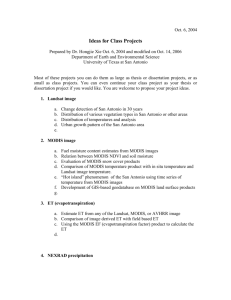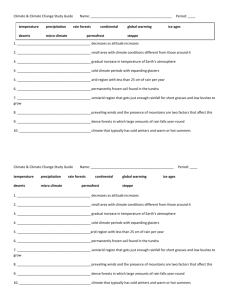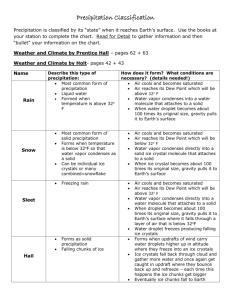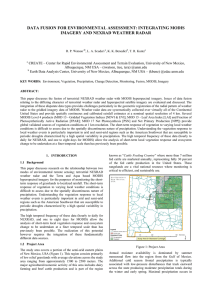Project ideas - The University of Texas at San Antonio
advertisement
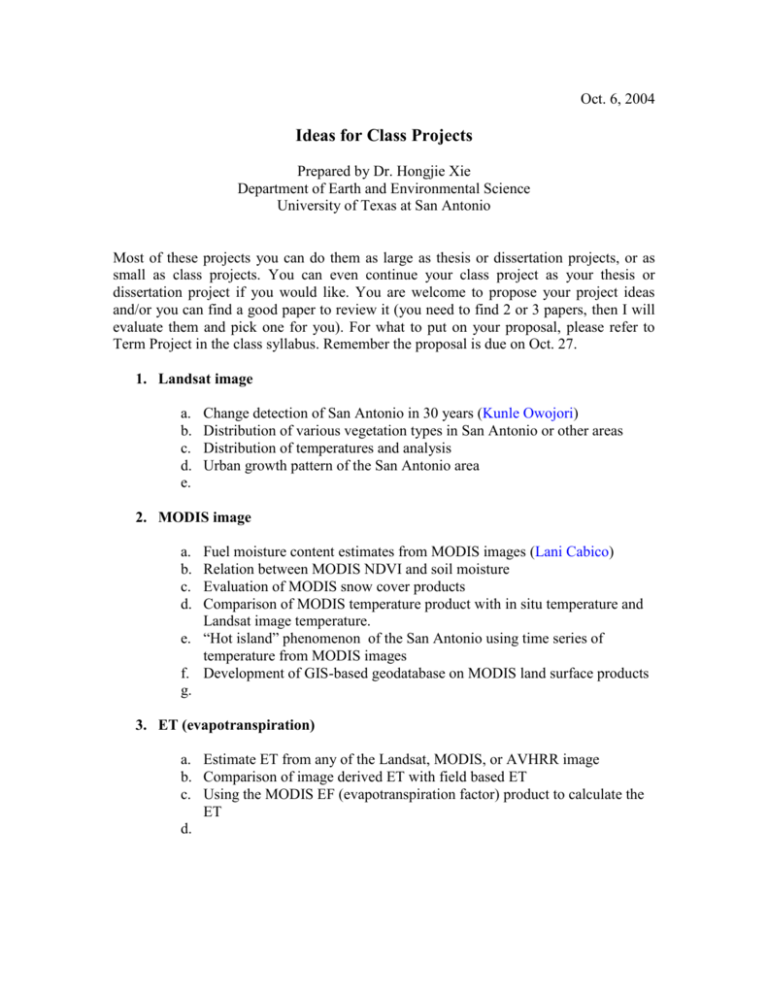
Oct. 6, 2004 Ideas for Class Projects Prepared by Dr. Hongjie Xie Department of Earth and Environmental Science University of Texas at San Antonio Most of these projects you can do them as large as thesis or dissertation projects, or as small as class projects. You can even continue your class project as your thesis or dissertation project if you would like. You are welcome to propose your project ideas and/or you can find a good paper to review it (you need to find 2 or 3 papers, then I will evaluate them and pick one for you). For what to put on your proposal, please refer to Term Project in the class syllabus. Remember the proposal is due on Oct. 27. 1. Landsat image a. b. c. d. e. Change detection of San Antonio in 30 years (Kunle Owojori) Distribution of various vegetation types in San Antonio or other areas Distribution of temperatures and analysis Urban growth pattern of the San Antonio area 2. MODIS image a. b. c. d. Fuel moisture content estimates from MODIS images (Lani Cabico) Relation between MODIS NDVI and soil moisture Evaluation of MODIS snow cover products Comparison of MODIS temperature product with in situ temperature and Landsat image temperature. e. “Hot island” phenomenon of the San Antonio using time series of temperature from MODIS images f. Development of GIS-based geodatabase on MODIS land surface products g. 3. ET (evapotranspiration) a. Estimate ET from any of the Landsat, MODIS, or AVHRR image b. Comparison of image derived ET with field based ET c. Using the MODIS EF (evapotranspiration factor) product to calculate the ET d. 4. NEXRAD precipitation a. Evaluate the NEXRAD precipitation product using rain gauge based precipitation data b. Relation between the NEXRAD precipitation with stream flow in a closed river basin or watershade (such as San Antonio river basin, or a small watershed) c. Analyze the water balance use the NEXRAD precipitation, ET, and stream flow for a selected river basin or watershed. d. Comparison of NEXRAD precipitation and TRMM precipitation e. Development of GIS-based NEXRAD Stage III precipitation geodatabase. f. High dense rain gauge cluster design for evaluating the NEXRAD precipitation g. Use high dense rain gauge data to derive a better NEXRAD Z-R relation h. NEXRAD radar as input for flooding prediction and alert system. i. Use NEXRAD precipitation to study the rainfall frequency and probability and their relations to El Nino and La Nina events. 5. TRMM precipitation radar a. Strom height and rainfall vertical profile b. Geographic patterns of shallow storm heights and their seasonal and interannual variability c. The relation of tropical rainfall with El Nino and La Nina events 6. Antarctic research a. b. c. d. Map sea ice, ice sheet, glaciers, icebergs Map sea ice thickness Monitor the dynamical changes of them Analyze the relation between these changes and global climate change How global climate change impact the sea ice, ice sheet How sea ice, ice sheet change will impact the global climate How ENSO might impact the sea ice and ice sheet. e. Antarctica geoinfomatics 7. Mars remote sensing a. Use MOLA and MOC images to study geomorphology or topographic modification of highland/lowland dichotomy boundary of Mars b. Use remote sensed gravity and/or magnetic data (from Mars Global Surveys Mission) to study the Mars crust and mantle structures c. Use TES, THEMIS or OMEGA images to map the minerals and rocks of Mars surface. d. Study the origin and evolution of methane in the Mars atmosphere. e. 8. Oak wilt diseases a. Use field based hyper-spectroradiometer to study the spectrum signatures of affected oak trees and healthy oak trees (Blake Weissling). b. Use remote sensing images and GIS to map the oak wilt disease center. c. Fly airborne hyperspectral image to study the oak wilt (Kevin Hankinson, possible next year) d. 9. Hyperspectral image processing and application a. Mineral exploration b. Environmental monitoring c. Oak wilt diseases study d. 10. RADAR image processing and application a. Soil moisture b. 11. LIDAR image processing and application
